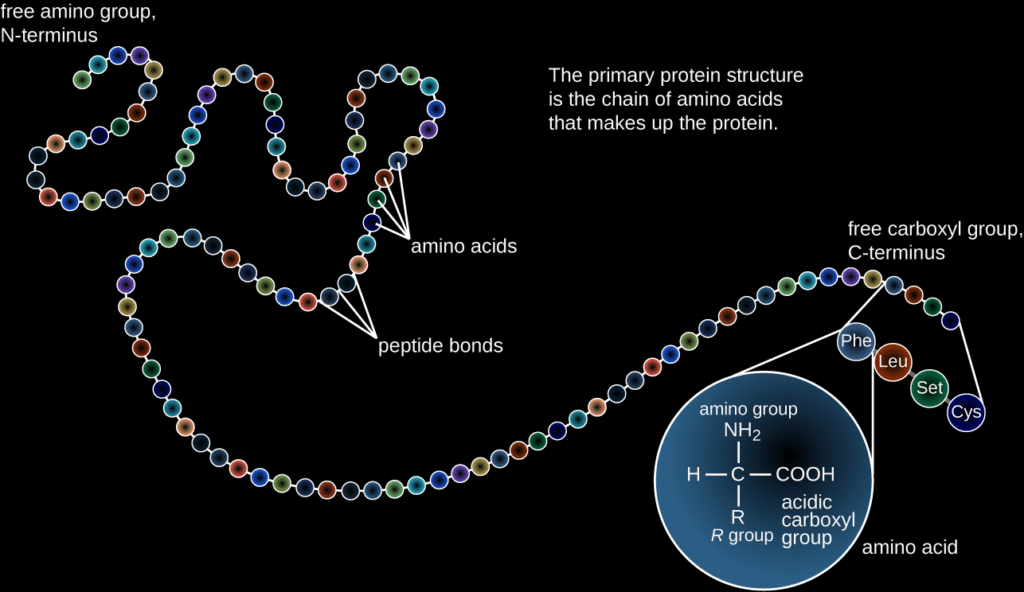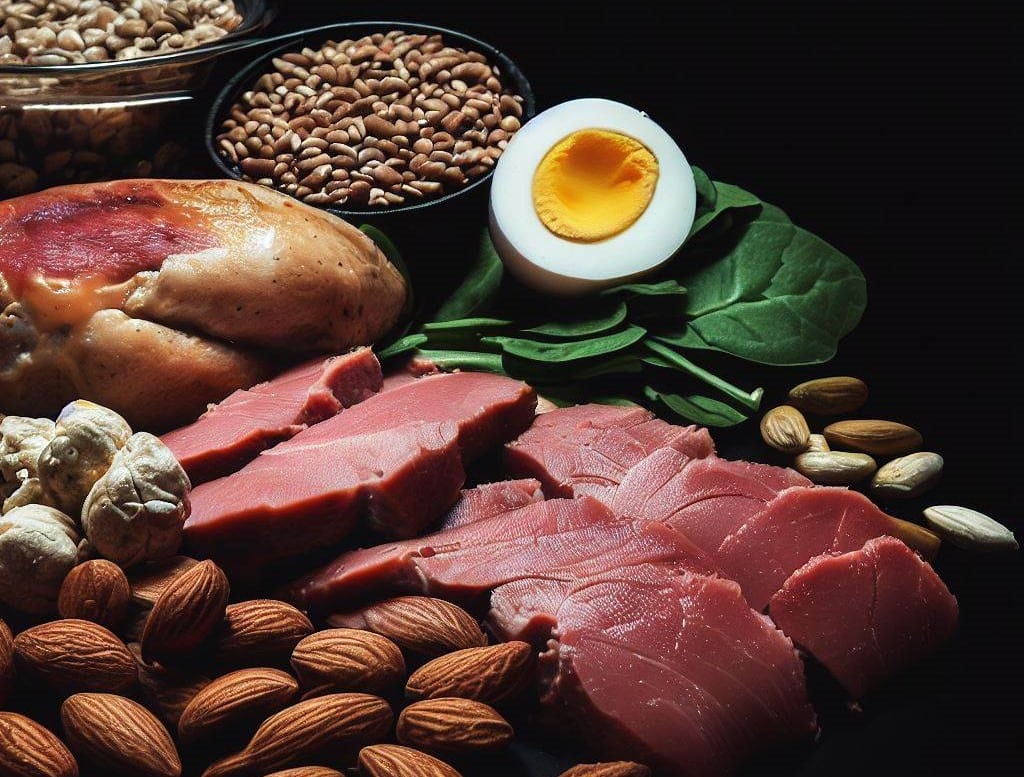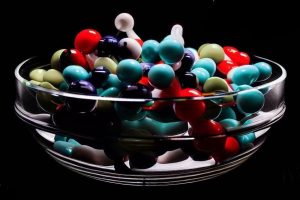A lack of amino acids can lead to depression
Amino acids are the building blocks of proteins. Multiple amino acids linked together are called peptides and multiple peptides linked together are polypeptides/proteins or otherwise called proteins. Hormones and neurotransmitters can also consist of amino acids. Each protein has a different sequence and amount of certain amino acids. Although depression is often a mix of complex factors, a lack of certain amino acids may contribute to depression. The amino acids that are most often on the low side are the amino acids involved in the formation of serotonin and dopamine:
Tryptophan: Tryptophan is an essential amino acid required for the production of serotonin, a neurotransmitter involved in mood and sleep. A tryptophan deficiency can potentially lead to reduced serotonin production and a disturbed mood.
Tyrosine: Tyrosine is a precursor of dopamine, noradrenaline and adrenaline. These neurotransmitters play a role in motivation, reward and energy levels. A deficiency of tyrosine can potentially lead to reduced production of these neurotransmitters, which can contribute to symptoms of depression.

What amino acids are there?
There are approximately 500 different amino acids in nature. The human body basically uses only 20, which we call fundamental amino acids. Of those 20, we can make 11 from other amino acids or we can reuse the amino acids that we get through food. We really need to get the other 9 amino acids through food and we call them essential amino acids.
Here is a list of basic amino acids
| Name | 3-Letter Symbol | 1-Letter Symbol | Molecular Formula |
| Alanine | Ala | a | c3H7NO2 |
| Arginine** | Arg | R | c6H14N4O2 |
| Asparagine | Asn | N | c4H8N2O3 |
| Aspartic acid | Asp | D | c4H7NO4 |
| Cysteine** | Cys | c | c3H7NO2S |
| Glutamic acid | Glu | E | c5H9NO4 |
| Glutamine | Gln | Q | c5H10N2O3 |
| Glycine** | Gly | G | c2H5NO2 |
| Histidine* | His | H | c6H9N3O2 |
| Hydroxyproline | Hyp | O | c5H9NO3 |
| Isoleucine* | Ile | I | c6H13NO2 |
| Leucine* | Leu | L | c6H13NO2 |
| Lysine* | Lys | K | c6H14N2O2 |
| Methionine* | Of | M | c5H11NO2S |
| Phenylalanine* | Phe | F | c9H11NO2 |
| Proline | Pro | P | c5H9NO2 |
| Pyroglutamatic | Glp | YOU | c5H7NO3 |
| Serine | Ser | S | c3H7NO3 |
| Threonine* | Thr | T | c4H9NO3 |
| Tryptophan* | Trp | W | c11H12N2O2 |
| Tyrosine** | Tyr | Y | c9H11NO3 |
| Valine* | Fall | V | c5H11NO2 |
*Essential amino acid
**Semi essential amino acid
What does a healthy body need?
A healthy body is never deficient in the amino acids that the healthy body needs to function. In general, people generally get enough non-essential amino acids. It is often the essential amino acids that someone is deficient in because they cannot be made from other amino acids in the event of a deficiency.
Protein requirement per day
In order to meet the daily protein requirement and therefore also the amino acids, there must actually be some protein at every meal to ultimately meet our needs. An adult with a normal exercise level needs approximately 1 gram of net protein per kilo of body weight per day. If someone weighs 75 kg, they should eat 75 grams of protein that contains the correct amino acids.
Some people need more protein
- Top athletes, especially in strength training
- People who do heavy physical work
- COPD patients
- People with serious illnesses
- People who are recovering/have had surgery
- Pregnant women and breast-feeding women
- Children who are growing
- To lose weight
Not all proteins contain the correct proportions of amino acids
The body can make the most optimal use of a protein from food if it best matches the amino acid profile of the human being. These are proteins that are very close to those of the body's own proteins in terms of structure and ratio of essential amino acids. The more amino acids present, the better. The essential amino acids must therefore be obtained through food to ultimately produce all 20 amino acids that our body needs.
The quality of a protein-rich food is indicated by the term Biological Value of the proteins. Animal proteins generally have a higher Biological Value than vegetable proteins, because animal proteins are more similar to our own proteins in terms of structure and amino acids used. That is why it is even more important for vegetarians to eat proteins (or combinations of proteins) that result in a high Biological Value!
Protein / Biological value
| Whey isolate | 140 |
| Whey concentrate | 120 |
| Breast milk | 100 |
| Egg white | 100 |
| Egg (whole) | 94 |
| Cheese | 84 |
| Chicken | 79 |
| Turkey | 79 |
| Casein (milk protein) | 77 |
| Soy | 74 |
| Fish | 70 |
| Lean meat | 69 |
| (Cow) milk | 60 |
| Unprocessed rice | 59 |
| Brown rice | 57 |
| White rice | 56 |
| Peanuts | 55 |
| Peas | 55 |
| Wheat | 49 |
| Soybeans | 47 |
| Flower | 41 |
| Corn | 36 |
| Kidney beans | 34 |
| Potatoes | 34 |
Foods you can combine
If different protein sources are eaten together, the amino acids that are too low in one product may be supplemented by the other product. Some well-known combinations are for example.
| Product | Combine with |
| Cereal products | Legumes, acidified dairy, meat, fish, cheese or egg |
| Vegetable | Oats, Rye, egg or sesame seeds |
| Potatoes | Egg, wheat or acidified dairy |
It is therefore advisable to alternate foods to obtain the right amino acids. Keep in mind that some foods score well in terms of protein content and less so in other areas. Nowadays it is easier and more beneficial for the body to buy a jar of essential amino acids and BCAA and eat healthy. This way you get the good of everything without too much of the disadvantage of, for example, some animal products.

A little more about protein preparations
If you really want to be sure that you are getting the right amino acids and in the right amount, there are a few supplements such as protein powders that are recommended.
Whey hydrolyzate is a predigested milk protein with high absorption and a high bioavailability of 140. For athletes and people with an increased protein requirement, this protein is ideal for obtaining the right amino acids in high numbers.
Pepto Pro is predigested casein protein that has been divided into peptides and these are even more absorbable, but the biological value is slightly lower than whey.
Silverback Protein is a vegetable pea protein supplemented with extra essential amino acids so that it has just as good biological value as whey, but plant-based and without lactose.
Essential amino acid blend is a mix of amino acids to supplement the proteins from your diet without actually adding extra proteins. This option is especially useful if you think you are eating enough protein, but not the right amino acids. Some manufacturers also add glutamine and BCAA to the essential amino acids, which is our preference. You can also add it yourself (via food).
Attention to these essential amino acids
Lysine, involved in concentration, the absorption of calcium, the growth of bone tissue, the build-up of collagen and support of the immune system, especially if you are sensitive to viral infections such as cold sores, it is important to have more than enough lysine in your diet.
Sources: fish, meat, egg, dairy such as cottage cheese, ricotta, yoghurt, avocado, nuts & seeds, legumes, crustaceans and shellfish, brewer's yeast, beans, wheat germ, legumes, bean sprouts.
Tryptophan, involved in resistance, stress management, good sleep, pain, constipation and depression.
Sources: egg, bananas, milk, rice, cottage cheese, meat, oats, nuts, lentils, seeds, legumes.
Leucine, involved in growth/repair of muscle tissue, wound and bone healing, sugar metabolism.
Sources: egg, rye, lima beans, almonds, cashews, dairy, rice, chickpeas, beef, chicken, fish, shellfish, whole wheat, almonds, cashews, lentils, beans.
Valine, growth and repair of muscle tissue, functioning of the nervous system, addictions and in people with a constant feeling of hunger.
Sources: egg, brown rice, cottage cheese, meat, lima beans, mushrooms, almonds, cashews, peanuts, sesame seeds, lentils, mushrooms, soybeans.
Isoleucine, involved in the construction and growth of muscle tissue and energy production at the cellular level.
Sources: egg, meat, dairy, shellfish, beans, rye, almonds, cashews, chickpeas, sunflower seeds.
Methionine, involved in skin/hair/nail health, combating fat deposits in the body, liver detoxification, histamine breakdown and as an antioxidant.
Sources: egg, meat, sardines, eggs, oats, bean sprouts, germs, nuts, avocado, seeds, dairy products, fish, crustaceans and shellfish, wheat germ, oat flakes, nuts, sesame seeds, lentils, soy beans, avocado.
Threonine, involved in brain metabolism, digestion and production of collagen and tooth enamel.
Sources: egg, fish, meat, almonds, peanuts, beans, dairy products, meat, fish, crustaceans and shellfish, wheat germ, oat flakes, nuts, legumes.
Phenylalanine, especially important for people with a lot of stress/pain/depression and are overweight.
Sources: dairy products, meat, poultry, fish, shellfish, wheat germ, oat flakes, nuts, lentils, soybeans.
Histidine, especially in children who grow quickly or people with many fears.
Sources: egg whites, meat, poultry, wheat germ, peanuts, sesame seeds.
Not essential, but often in short supply
Glutamine, is not essential but can certainly be essential in case of, for example, a leaky intestine, sensitivity to addiction or sweat that smells like ammonia. Glutamine deficiencies can lead to all kinds of allergies and intolerances, such as cow's milk, soy, tree nuts, peanuts, but also to deficiencies in GABA, our body's own 'tranquillizer'.
Sources of glutamine: liver, dairy products, cabbage, cottage cheese, ricotta, avocado, wheat germ, whey.
Arginine, is not essential but can be very essential for (wound) healing, high blood pressure, fertility problems, athletes or slow regeneration after exercise.
Sources: cheese, meat, poultry, eggs, fish, shellfish, nuts & seeds (especially walnuts, peanuts, pumpkin seeds, sesame seeds/Tahini, macadamia, hazelnuts and almonds), buckwheat, chocolate, peas, avocado, soy, garlic, ginseng.
Tyrosine, especially in the case of depression, liver, thyroid and/or adrenal gland disorders, very essential.
Sources: herring, avocado, meat, almonds, sesame seeds, chickpeas, pecans.
Specific amino acids against depression, compulsions, addictions and inflammatory diseases
There are a number of forms of amino acids that have been proven to be very effective against certain conditions. These specific forms of amino acids often have an extra atom (group) on the molecule so that they can reach certain places in the body better. Below are the specific forms of amino acids that work extra well.
N-acetyl cysteine
N-acetyl cysteine works against addictions, premature aging, inflammatory diseases, depression, compulsive behavior (OCD), stress and also increases the fertility of men and women. N-acetyl cysteine can help fight:
- Mucus in airways and/or sinuses, respiratory diseases (respiratory tract infections, emphysema, chronic bronchitis, cystic fibrosis, asthma, sinusitis, hay fever, pulmonary fibrosis)
- Chronic liver diseases
- Aging
- HIV/AIDS (improvement glutathione status)
- Immunosenescence in the elderly (aging immune system resulting in reduced resistance and chronic low-grade inflammation)
- Heart and vascular disease
- Sports (better endurance, faster recovery)
- Addictions (smoking, gambling, cannabis, cocaine, methamphetamine, heroin)
- OCD (obsessive-compulsive disorder)
- Sjögren's disease (eye complaints)
- Sickle cell disease
- Cancer (prevention)
- Diabetes mellitus (improvement of glycemic control, prevention of complications including thrombosis)
- Pancreatitis
- Kidney diseases
- PCOS (polycystic ovary syndrome)
- Endometriosis
- Infection with Helicobacter pylori (causing peptic ulcer, stomach cancer)
- Arthritis
- Crohn's disease
- Autism
Depression, bipolar disorder (depressive phase) - Schizophrenia
- Brain injury, spinal cord injury, stroke
- Prevention of noise-induced hearing loss
N-acetyl cysteine does not occur in our diet, but the body makes it from L-cysteine. In many cases of the diseases described above, too little N-acetyl cysteine is produced from L-cysteine and then supplementation is a solution.
The daily dose of N-acetyl cysteine (NAC) is 1000 mg and the therapeutic daily dose is approximately 2000 mg. It is best to take it on an empty stomach with water.
Be careful with medication. N-acetyl cysteine (NAC) can increase the effect of antidepressants, nitroglycerin and anticoagulants. Consult your doctor first if you are taking medication.
Acetyl-L-carnitine
Acetyl-L-carnitine works particularly well against depression and inflammatory diseases. Acetyl-L-carnitine (ALCAR) increases the synthesis of serotonin (low serotonin causes depression) and it ensures that the mitochondria, the energy factories in the cells, work better so that it prevents depression due to exhaustion. Acetyl-L-carnitine can help with the following conditions:
- Aging (decreased endogenous carnitine synthesis)
- Low carnitine intake with food (vegetarianism, veganism)
- Chronic fatigue (including cancer, multiple sclerosis, celiac disease, old age, chronic fatigue syndrome, hepatitis C, beta-thalassemia)
- Depression in the elderly
- Age-related cognitive decline, dementia
- Cardiovascular diseases (intermittent claudication, angina pectoris, myocardial infarction, congestive heart failure, myocarditis, premature ventricular contractions, cardiomyopathy, hypertension, stroke, Raynaud's disease)
- Diabetes mellitus, obesity, metabolic syndrome
Neuropathy (diabetes, chemotherapy, HIV medication) - Age-related macular degeneration
- Reduced fertility
- Fibromyalgia
- Cancer cachexia
- Hyperthyroidism (not hypothyroidism!)
- Sports (improvement endurance)
- COPD (for increasing exercise capacity)
- Hepatic encephalopathy, liver cirrhosis
- Nonalcoholic fatty liver disease and steatohepatitis
- Kidney failure/kidney dialysis
- HIV infection
The recommended dosage is 1 to 3 grams per day, preferably not in the evening on an empty stomach.
Be careful with medication. Acetyl-L-carnitine (ALCAR) can increase the effect of antidepressants, nitroglycerin and anticoagulants. Consult your doctor first if you are taking medication.
Nutrition and physical health is part of Trip Therapy
A healthy body gives a greater chance of a healthy mental state and vice versa. Psychedelic therapy in combination with a healthy lifestyle significantly increases the chance of combating the symptoms of mental complaints. Here are some reasons why this combined approach can yield positive results:
- Neuropsychological effects: Psychedelics, such as psilocybin (in magic mushrooms) and lysergic acid diethylamide (LSD), have potentially therapeutic effects on the brain. They can strengthen communication between different brain areas and create new connections, which can lead to increased insight, introspection and emotional well-being. These effects can address the mental complaints and help the person develop new perspectives.
- Emotional processing: Psychedelic therapy can induce deep and intense emotional experiences. This can enable people to recognize and deal with ingrained patterns, negative thoughts and traumatic memories. It can help reframe experiences and promote emotional processing, which in turn can lead to relief from mental complaints.
- Increasing self-insight and introspection: Psychedelic experiences can induce a sense of connection and unity with the self, others and nature. This can increase self-insight and promote a deeper understanding of one's own mental state. Through this introspection, people can become aware of underlying causes of their mental complaints, such as unprocessed traumas, negative beliefs or destructive behavioral patterns.
- Strengthening therapeutic processes: In a therapeutic setting, psychedelics can enhance the effectiveness of other therapeutic approaches. It can facilitate communication with therapists, break down barriers and speed up therapeutic processes. Psychedelic therapy can also increase overall acceptance of therapy, making people more open to change and growth.
- Healthy lifestyle as a supplement: A healthy lifestyle, including good nutrition, exercise, adequate sleep and stress management, can promote overall mental health and well-being. By embracing a healthy lifestyle, people can increase their physical and mental resilience, which can contribute to the success of psychedelic therapy. In addition, a healthy lifestyle can help support long-term positive changes and prevent relapses.
Take advantage of our complete approach
At Triptherapie, completing the intake is the first step you can take to qualify for psychedelic therapy including advice on physical health. Through the intake, we can assess whether certain neurotransmitters are too low and what foods and supplements you can use to improve neurochemistry. Improving neurochemistry beforehand has a number of advantages such as a better psychedelic session with less risk of a negative experience such as a bad trip. Furthermore, the improvement of neurochemistry can already mean a better state of mind. Take the first step and complete the intake:
